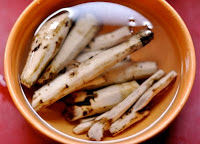 ACROSS MUCH OF North America, burdock (Arctium sp.) is a common weed in overgrown fields and waste areas. It’s a biennial and can grow to immense size, with two-foot leaves and flower stalks up to nine feet tall. Like stinging nettles and poison ivy, many of us have memories of encountering burdock as kids—a sweater covered in burrs, say, or the chore of taking a wire brush to Fido after a romp in the patch.
ACROSS MUCH OF North America, burdock (Arctium sp.) is a common weed in overgrown fields and waste areas. It’s a biennial and can grow to immense size, with two-foot leaves and flower stalks up to nine feet tall. Like stinging nettles and poison ivy, many of us have memories of encountering burdock as kids—a sweater covered in burrs, say, or the chore of taking a wire brush to Fido after a romp in the patch.
 Burdock roots grow deep, often more than two or three feet beneath the surface, and need to be coaxed out of the ground so as not to break. First-year roots are the ones to target for food; once the plant forms a flower stalk in the second year the root turns woody.
Burdock roots grow deep, often more than two or three feet beneath the surface, and need to be coaxed out of the ground so as not to break. First-year roots are the ones to target for food; once the plant forms a flower stalk in the second year the root turns woody.
Kinpira Gobo
The Japanese are great lovers of burdock and ascribe many medicinal values to the root. It’s starchy like a potato and has the round, buttery flavor one associates with artichoke heart. There’s also a sweetness and even a faint citrusy edge. Kinpira Gobo is a traditional Japanese dish and easy to make. The addition of shichimi togarashi is recommended.
 1/2 lb burdock root
1/2 lb burdock root
1-2 carrots
1 tbsp vegetable oil
1 tbsp sesame oil
1 tbsp sake
1 tbsp mirin
1 tbsp soy
2 tsp sugar
1 tsp toasted sesame seeds
Shichimi togarashi (Japanese 7-spice blend), to taste (optional)
1. Lightly peel the burdock root, then julienne and remove to a bowl of water for 10 minutes.
2. Julienne carrots.
3. Heat oil in a wok or frying pan and stir-fry burdock for a few minutes. Stir in carrots and cook another minute or two before adding the remaining ingredients.
4. Stir-fry until the liquid has evaporated, leaving a glaze on the vegetables.
5. Serve immediately with a sprinkling of sesame seeds and shichimi togarashi.
You can also find commercially grown burdock in many Asian markets. The root will be longer, straighter, and prettier than wild burdock.



I love me that gobo. Though I have to be surreptitious when I use it, since my New England-born-and-bred husband refuses to consider it a food (rather like your groundskeeper, I suspect). So I throw it into soups and stews and stir-fries with abandon where it becomes (visually, at least) just another root vegetable. Maybe someday I’ll tell him he’s been eating burdock all along. But not just yet.
Awesome post as usual, thank you very much for sharing this one, I always wondered – peace
Great stuff!
I love the concept of your blog. The most exciting thing in the world to me is happening upon a gastric pleasure in an unexpected place. I can’t wait to try to rustle up some of these finds! And…I can’t wait to figure out what it is these people pull over on the side of the road and fill bags with here in the “way north” on Highway nine between Lake Stevens and Arlington. Perhaps you’ve already explored this??? I find your writing style very engaging, as well!
I’ll have to try this, but I’d be worried about soil contamination in the type of empty lots burdock likes to grow in.
great looking stuff. I don’t think I have ever had burdock root.
kab – Shhhh…what hubby doesn’t know can’t hurt him–in fact, it can help him in this case.
Ruralrose – Give it a try, you’ll dig it, so to speak.
Bpaul – Thanks!
Donata – What time of year are you spotting all these “roadkill foragers” on route 9?
gabrielamadeus – I hear you. Everyone’s comfort zone is different. Try to locate patches free of chemical spraying or agricultural runoff. Legacy soil contamination in urban areas is harder to evaluate.
Matt – You’re a root guy. Try some from Uwajimaya, then we’ll go get some from my spot, which is close to you.
I love burdock but unfortunately it’s not so available in the States. Delicious recipe, thanks for posting!
Not yet played with burdock, although there’s no real reason. Funny you should mention artichoke heart taste, as I get that feeling when I eat salsify roots.
Maybe I’ll do a big ole’ farewell-to-winter root fiesta with burdock, salsify et al…
The stalks are wonderful too–my favorite wild forage (tho they do get your hands messy.) Now is the time to make a nice stir of gobo, evening primrose and wild carrot roots.
Love this post. Burdock is the bane of my fields (I live on a farm, and it shows up in paddocks, chicken coop, open field, you name it) but I have always loved gobo in Japanese restaurants and wondered if my annoying burdock could be redeemed. So happy you’ve given me the answer (not to mention yet another spring project.)
thanks for the recipe! must try it
Your recipe is pretty much what I learned when growing up… but I like to kick it up a notch with a some thin sliced aburage (fired tofu), thin sliced fish cake (tempura type kamaboku), dash of hot peppers, shiitake mushrooms, and bit of hijiki seaweed. Put this over a bowl of hot or cold rice and enjoy it with a cup of green tea.